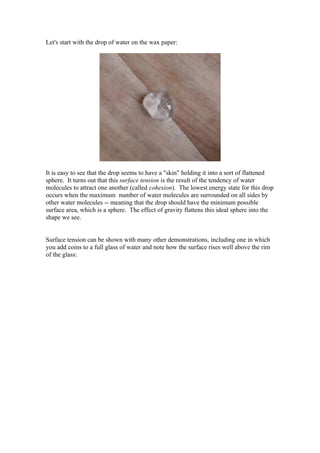
Understanding Surface Tension Through Water Droplets
- 1. Let's start with the drop of water on the wax paper: It is easy to see that the drop seems to have a "skin" holding it into a sort of flattened sphere. It turns out that this surface tension is the result of the tendency of water molecules to attract one another (called cohesion). The lowest energy state for this drop occurs when the maximum number of water molecules are surrounded on all sides by other water molecules -- meaning that the drop should have the minimum possible surface area, which is a sphere. The effect of gravity flattens this ideal sphere into the shape we see. Surface tension can be shown with many other demonstrations, including one in which you add coins to a full glass of water and note how the surface rises well above the rim of the glass:
- 4. Though teachers often talk about surface tension being like a "skin", this is not really an accurate model, as there is no other compound other than water in the glass. In addition, the surface does not react to being poked with a stick as a skin would. In fact, the water not only sticks to itself, it sticks to the wood as you can see by looking at the arrows in the picture. This is called adhesion because the attraction is to a different substance. In all systems within which water interacts with another surface, both adhesion and cohesion are factors. When cohesion is more of a factor, the water forms spherical
- 5. droplets; when adhesion is more of a factor, we get sheets of water. water drop on oiled plastic wrap (cohesion of water and only a little adhesion of water to water drop on untreated plastic wrap plastic) (cohesion of water molecules to one another as well as strong adhesion of water to plastic) The wax on the wax paper, it would seem, acts like the oil. You might have read somewhere that wax and oil are hydrophobic and might think that the wax and water are repelling one another. However, this is not quite true, as you will see if you turn a piece of wax paper with droplet on it upside down: Since the water drops stay on the wax paper, there must be some sort of attraction between these materials. It turns out the force of attraction between the water and the wax is actually quite strong, but it is less strong than the water-water (cohesive) force. For a good short discussion of a common misconception about hydrophobic materials,
- 6. check out the Bad Chemistry page at http://www.princeton.edu/~lehmann/BadChemistry.html#hydrophobic. On clean glass, the forces of adhesion between water and the surface are stronger than they are on oil or wax. The following image is of a mirror half of which I treated with butter (right) and half of which I left alone (left). I then put the mirror in the freezer to cool it and harden the butter, removed it, and dropped some water on it. Notice that the water on the left side (where cohesion and adhesion were both major factors) formed a sheet. On the right, where cohesion won out over adhesion, the water formed drops: So now we have a mental model of what is going on with a drop of water on a surface, and this should help us think about the original problem. The water drop is close to spherical because of the cohesion of the water molecules. (Gravity squashes it, however.) This ball of water, of course, is also somewhat attracted to the wax paper (adhesion); thus, when it is tilted, the surface of the water "sticks" to the wax, and the drop rolls. For more discussion of intermolecular forces, a good webpage is Intermolecular Bonding -- VAn Der Waals Forces, at http://www.chemguide.co.uk/atoms/bonding/vdw.html Now let's look at the glass again:
- 7. Like the water drop, the surface tension on the water on this glass will be lost if you add some soap to the water. One end of each soap molecule is attracted to the water molecules and comes between them. If one floats a paper clip on the water (bend a bit of the clip up so it is easy to put it on the surface carefully), the effect of soap can be observed easily. This principle is behind the trick of putting soap on your bathroom mirror to keep it from fogging. The fog on a mirror is caused by many tiny drops of water condensing on the mirror and reflecting light in a variety of directions. The soap disrupts the cohesion of the water molecules, causing the water to form sheets (through which the image can be seen relatively easily) rather than drops. By the way, if we come back to our original drop of water on the wax paper, we can break the surface tension by adding soap, and we'll see that the drop changes into a flat puddle. Notice the relatively flat profile: When we reduce the force of cohesion (by introducing soap), the drop changes shape as now the forces of adhesion and cohesion are more nearly the same.